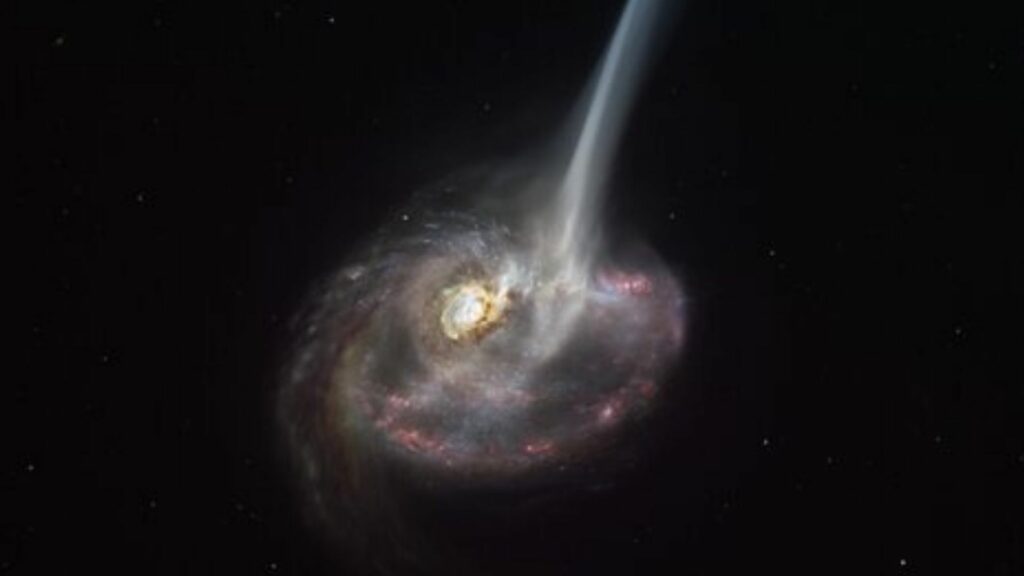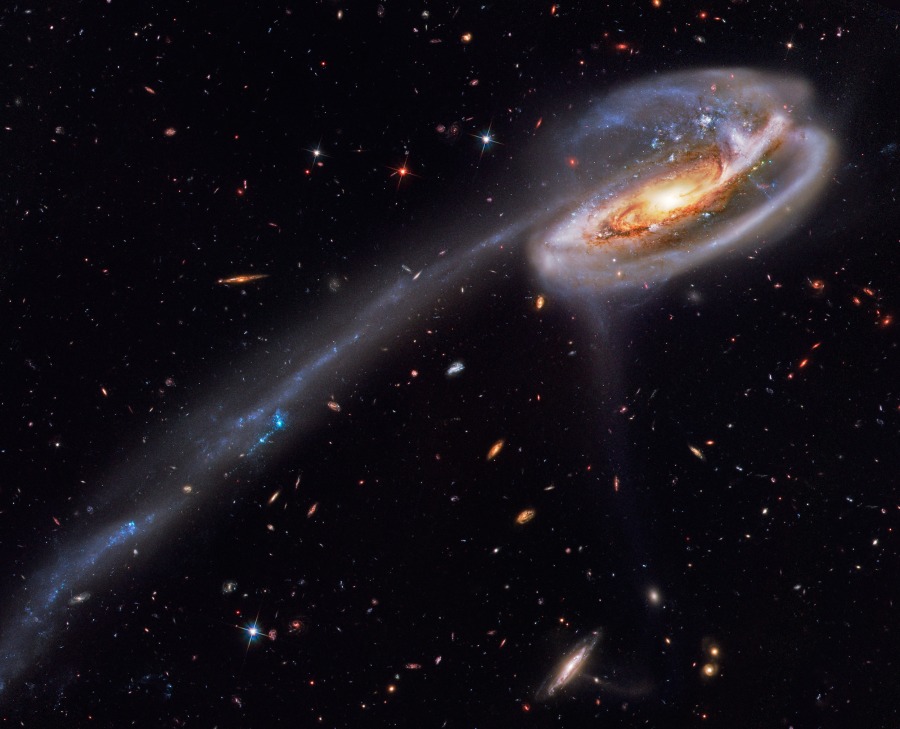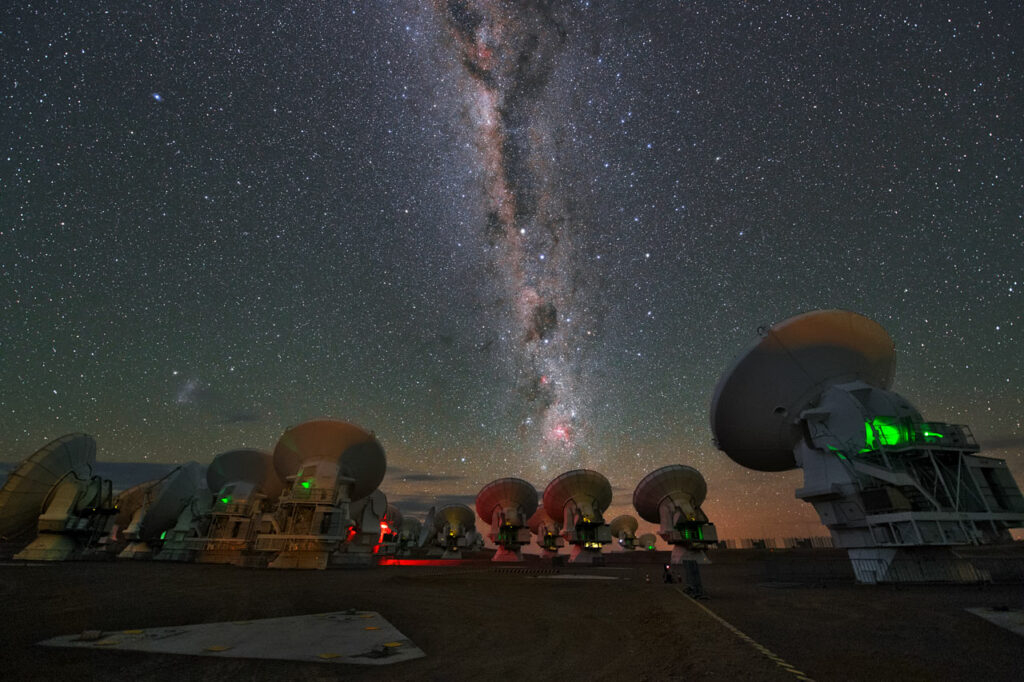The process that causes the end of star formation in galaxies, their transition to an inactive phase and thus their figurative ‘death’ has been a puzzle for astronomers and astrophysicist for some time. Many researchers believe that ‘galactic death’ begins with the ejection of a massive quantity of gas, but thus far, researchers have failed to capture evidence of the escape of this star-forming fuel in such volumes. Thus the confirmation of how this transition to galactic quintessence occurs has also proved elusive.
Now an international team of astronomers have used the Atacama Large Millimeter/submillimeter Array (ALMA) located in the desert region of Chile to spot a distant galaxy in which such a massive ejection of gas is progressing.
“Using ALMA we have discovered a distant galaxy, ID2299, which is ejecting about half of its cold gas reservoir out of the galaxy,” Annagrazia Puglisi, Centre for Extragalactic Astronomy, Durham University, lead researcher on the study, tells ZME Science. “This is the first time we have observed a typical massive star-forming galaxy in the distant Universe about to ‘die’ because of a massive cold gas ejection.”

ID2299 is so distant that the light it emits takes 9 billion years to reach Earth, which means the team were able to observe it at a time when the universe was just 4.5 billion years old.
The rate of gas ejection that ID2299–a galaxy with a similar mass to the Milky way– is experiencing is equivalent to 10,000 Suns per year, removing an extraordinary 48% of its total cold gas content. In addition to this, the galaxy is still forming stars at a rapid rate, hundreds of times faster than the star formation rate of our own galaxy.
Puglisi explains that the gas ejection, together with a large amount of star formation in the nuclear regions of the galaxy, will eventually deprive the galaxy of the fuel need to make new stars.
“This would stop star formation in the object, effectively halting the galaxy’s development.”
Annagrazia Puglisi, Centre for Extragalactic Astronomy, Durham University
The team’s research, published in the latest edition of the journal Nature Astronomy, is significant because it represents three ‘firsts’ for astronomy. “This is the first time we observe a typical massive star-forming galaxy in the distant Universe about to ‘die’ because of a massive cold gas ejection,” explains Puglisi. “Also, for the first time, we were able to tell that massive gas ejection might be frequent enough to cause the cessation of star formation in a large number of massive distant galaxies. Finally, we were able to study the physical properties of the ejected gas in a distant galaxy.”
The researcher goes on to explain that these factors are important in the understanding of the triggering mechanism of the ejection– the galaxy’s distinct tidal tail.
Galactic Collisions and Tidal Tails
The research team that discovered ID2299 believe that it was created during a collision between two galaxies and their eventual merger. Ironically this process seems to have triggered the rapid gas loss that will eventually cause it to become inactive.

“ID2299 is a galaxy with a large mass in stars and is forming new stars at a rate 300 times faster than our Galaxy– a result of the collision between two galaxies,” co-author Chiara Circosta, Department of Physics & Astronomy, University College London, tells ZME.
The main clue that points towards ID2299’s creation by collision is the fact its ejected gas has taken the form of a tidal tail. These elongated streams of stars and gas that reach into interstellar space are often too faint to see and are theorised to be the result of galactic mergers.
“Collisions between galaxies are very powerful and spectacular phenomena. During the interaction, tidal forces develop and can trigger ejection of gas through tidal tails,” says Circosta. “Our study suggests that these ejections could be frequent enough to stop the formation of new stars in a large number of massive galaxies in the distant Universe.
“Our research shows that these interactions can have an important role in the life-cycles of galaxies.
Chiara Circosta, Department of Physics & Astronomy, University College London
What makes the team’s findings even more impressive is the fact that it’s a discovery that occurred predominantly through good fortune.
Serendipity and a Series of Firsts
Because tidal tails of gas such as the one that the team observed being ejected from ID2299 are extremely faint and thus, difficult for astronomers to observe. In fact, the team weren’t looking for a galaxy like ID2299 at all.
“The discovery of this object was serendipitous. I was inspecting the spectra of 100 star-forming galaxies from the ALMA telescope,” says Puglisi, who goes on to explain that the spectrum of galaxy ID2299 immediately caught her attention as it displayed an excess of emission near the very prominent emission line from the galaxy. “I was very surprised when I measured the flux of this excess emission because it indicated that the galaxy was expelling a large amount of gas.
“I was thrilled to discover such an exceptional galaxy! I was eager to learn more about this weird object because I was convinced that there was some important lesson to be learned about how distant galaxies evolve.“
Annagrazia Puglisi, Centre for Extragalactic Astronomy, Durham University
The discovery of ID2299 sparked a discussion within the team about the mechanism that is causing the gas ejection of gas at such a rapid rate. They concluded that alternative mechanisms simply couldn’t account for ejection in such large amounts.
“We discussed a lot to understand what could have been the possible cause of this phenomenon. Broad components are fairly common in the spectra of distant galaxies and are typically associated with galactic winds,” says Puglisi. “Nor the active black hole nor the strong star formation hosted in ID2299 were powerful enough to produce this ejection.
“The numbers didn’t just add up.”

The next steps for the team are to use ALMA to make high-resolution observations of ID2299 and the motion of gas within it in order to better understand the gas ejection occurring there. Looking beyond this galaxy, Puglisi says she will also look for similar occurrences in other galaxies.
“I personally find quite fascinating the study of galaxy interactions and mergers. These phenomena are visually spectacular,” the researcher adds. “I find quite poetic that galaxies can get close to each other and influence their life and evolution so dramatically.”
The research the team presents could either overturn current theories that suggest star-forming material is actually ejected by the activity of supermassive black holes at the centre of galaxies or could provide another mechanism by which this can occur. Either way, the discovery represents a significant step forward in our understanding of how galaxies develop.
“I see galaxy evolution as a complex puzzle that researchers are trying to complete through their studies,” Circosta concludes. “A crucial part of the puzzle is about the mechanisms that halt the formation of new stars and ‘kill’ galaxies.
“Witnessing such a massive disruption event allowed us to shed new light on one of the possible culprits responsible for the death of distant galaxies. This adds an important piece to the puzzle of galaxy evolution!”
Chiara Circosta, Department of Physics & Astronomy, University College London
Original research:
Puglisi. A., Daddi. E., Brusa. M., et al, ‘A titanic interstellar medium ejection from a massive starburst galaxy at z=1.4,’ Nature Astronomy, [2021], [DOI: 10.1038/s41550-020-01268-x].






